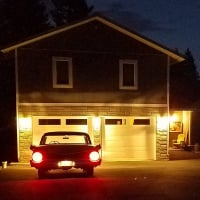Welcome! Here are the website rules, as well as some tips for using this forum.
Need to contact us? Visit https://heatinghelp.com/contact-us/.
Click here to Find a Contractor in your area.
If our community has helped you, please consider making a contribution to support this website. Thanks!
Radiant electric ceiling heating
Options
dscottmilner
Member Posts: 5
Looking for information on my electric ceiling heating system.
I must be the only person in Australia with this type of heating
I must be the only person in Australia with this type of heating
0
Comments
-
Are there some problems with it, which you wish to solve?--NBC0
-
-
Personally I don't like them, I see them as a fire hazard even though there seems to have been few fires attributed to them. There were some recalls but you'd have to know the brand to search it.
It just doesn't work in a cold climate, radiant in the floor works because that's where you're feet are.
Electric radiant in the ceiling has too long a run time and consumers usually end up with a high utility bill.0 -
Here's one recall-- FLEX-HEAT CEILING HEATING SYSTEMS
Ontario Hydro is warning homeowners that Flex-Heat electric radiant ceiling heating is dangerous and that if your house has such a system you must disconnect it immediately. Ontario Hydro says the system can fail without warning and may become a fire hazard. Most houses with Flex-Heat have a label on the electrical panel box or a label on the thermostat indicating that it is a Flex-Heat system. Some houses with Flex-Heat do not have labels. These houses can be identified as having radiant heat by the fact that the rooms are heated but have no ductwork, no radiators and no electric baseboard heaters. Most houses with radiant heat have individual room or zone thermostats. If the house has electric radiant heat and no stickers indicating that it is Flex-Heat, the attic should be inspected (under the insulation) to determine whether black plastic panels have been installed immediately above the ceiling. Flex-Heat was only installed after 1975.0 -
GreenGene said:
It just doesn't work in a cold climate, radiant in the floor works because that's where you're feet are.
Electric radiant in the ceiling has too long a run time and consumers usually end up with a high utility bill.
If you are referring to ceiling radiant in general you are dead wrong as to its performance in a any type of heating climate.
1 -
Several spec homes were build here in northern Maine in the early to mid 80's with electric radiant ceilings, to my knowledge the majority are still in service.... It was the last of "the future of energy: cheap nuclear electricity". I have been in some houses with it, the owners say it works well. Still kinda scary IMHO.
SFMServing Northern Maine HVAC & Controls. I burn wood, it smells good!0 -
I never met anyone that liked it, that's just been my experience and here in Ct, thanks to ENRON and deregulation, we have the highest electric rates so it's very expensive to run.0
-
If you're going to try and tell me that radiant in the ceiling is as comfortable as radiant in the floor, sorry, there is no way, and it'll be much more expensive to run, it's a ridiculous design based around it being easier and cheaper for a builder and whenever those are the two primaries in building design, the design is going to suck.0
-
Why is it a rediculous design?
Keep in mind hydronic.0 -
Electric radiant in the ceiling is ridiculous unless you want to heat the floor above, like I said I never saw it work, never met anyone that lived in a house with it that liked it especially the electric bills, all they said was "what can you replace it with and what will it cost?".0
-
-
Ceiling radiant when properly installed, and when used with an efficient delivery system (hydronics) has many benifits over floor radiant.
Ceiling radiant is not effected by floor covering choices, furniture blocking output, lack of density due to cabinetry in kitchens, baths etc. is not limited to the 87* surface temps that floors are. Even less with wood floors. So higher outputs can be achieved with ceilings.
Don't fall for the heat rises belief either.
I won't disagree neutral floors are nice in barefoot areas.
Don't forget the walls either.
2 -
I agree with hydronic, it's electric I'm focusing on. I don't think I've seen hydronic in the ceiling, walls yeah.
I really don't think electric heating elements of any kind should be installed in the walls, floors or ceilings of any home unless the material it's imbedded in is flammable.0 -
The electric ceiling radiant I have seen used wires embedded in either concrete or plaster. As long as there is some amount of insulation behind it, I'm quite certain that modulating it with ODR (possibly with the addition of an embedded temp sensor) would produce excellent occupant comfort levels.
BTW, inflammable things burn quite well.1 -
woops, repaired, most I've seen are the 4x8 sheetrock panels, if you go up in the attic and pull back the insulation you find straight brown lines in the paper from the heat, the other stuff I saw was a grid you stapled to the bathroom floor and tiled over it.0
-
Categories
- All Categories
- 87.3K THE MAIN WALL
- 3.2K A-C, Heat Pumps & Refrigeration
- 61 Biomass
- 427 Carbon Monoxide Awareness
- 119 Chimneys & Flues
- 2.1K Domestic Hot Water
- 5.8K Gas Heating
- 114 Geothermal
- 165 Indoor-Air Quality
- 3.7K Oil Heating
- 76 Pipe Deterioration
- 1K Plumbing
- 6.5K Radiant Heating
- 395 Solar
- 15.6K Strictly Steam
- 3.4K Thermostats and Controls
- 56 Water Quality
- 51 Industry Classes
- 50 Job Opportunities
- 18 Recall Announcements





